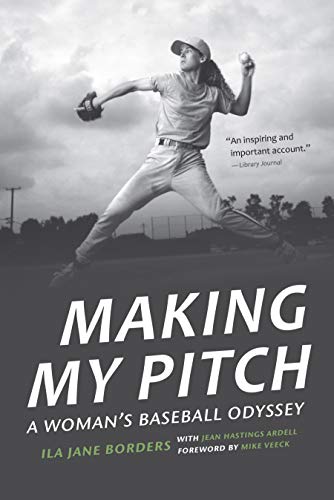Book Review: Making My Pitch

A gay teenager becomes the first woman awarded a scholarship to pitch for a men’s baseball team at a private Christian college and eventually, makes it to the minor leagues. It sounds like a lot of hats to wear, but only a baseball cap will suffice for Ila Borders, who recounts her baseball career – from little league to the pros – in Making My Pitch: A Woman’s Baseball Odyssey. Ila tells her readers early that her name means “island dweller” – a fitting metaphor for a life set on a unique path, outside of the norm, and in pursuit of an authentic identity. Borders’s co-author is Jean Hastings Ardell, a skilled writer and friend, who has followed Borders’s career since the 1990s. Together, with a foreword by baseball executive Mike Veeck, they deliver a memoir full of triumphs and tragedies that serves as an exemplar for resilience and determination.
Readers will find themselves drawn to her story from the start, even in the uniquely
designed cover. The dust jacket is striking, featuring Annie Leibovitz’s iconic photo of Borders. In a stark black and white photo, Borders is captured in mid-pitching motion, set before a backdrop of cloudy skies. Still, her motion and focus are moving forward, undeterred. She is a warrior amidst the ominous, which befits the title, A Woman’s Baseball Odyssey. Sixteen pages of black and white photos are also included in the book and document Borders’s personal, athletic, and professional accomplishments.
Each chapter is unique – the first few beginning with in-the-moment game experiences, told in the present. High pressure situations, tough outs, and some play-by-play commentary highlight the game-within-the-game that is familiar to all baseball pitchers. The remainder of each chapter then reflects to Borders’s journey through little league, high school, and college as well as issues surrounding family, religion, and sexuality. The back and forth may confuse some readers, but this style only illustrates the universality of baseball fundamentals in that regardless of what level of ball is being played, the game does not change. Just as many LGBTQ+ people feel they are in a constant state of coming out their entire lives, in ways large and small, so is Borders’s experience as a baseball player. She is denied the luxury of merely succeeding or failing as a player compared to her male counterparts. Media hype surrounds her participation in baseball from her days on youth teams through the professional leagues. Win or lose, she must first justify her reasons for even showing up, unlike her teammates. The pattern serves her well in other aspects of life. One powerful example of self-awareness is her seemingly uncomplicated identity living as a gay Christian. Naturally, there are doubts about each component of her life while growing up, but absent from this book is any one epiphany where the two parts suddenly coexist. They are simply two intrinsic aspects of her life that do not require any further justification toward one another.
The time and context of women’s sports are important to note. Borders’s professional debut in 1997 occurs in the same summer that women’s professional basketball and softball leagues premiered. It is one year after U.S. women won gold in every major team sport at the Atlanta Olympic Games and the fourth season for the Colorado Silver Bullets, an all-female baseball team that competed against men’s minor league and semi-pro teams. In short, women’s sports team were hot at the time. Being the only woman on the team or in the league, however, resulted in a whole new set of unnecessary obstacles, which Borders nevertheless handled with class and humor. While her pioneering accomplishments make her book a worthy addition to any sports history collection, Borders truly delivers for baseball fans an inside look at the less-than-glamorous life of a minor league baseball player. If the casual reader assumes the benefits of being a professional athlete are universal, Borders’s account of daily practices and games, living in motels and basement apartments, and uncomfortable travel – all for little more than the privilege of playing at a higher level, should put those assumptions to rest. A particularly memorable anecdote involves Borders, with already limited funds, splurging on a box of cereal. With no money for milk, she uses water from the hotel room sink. The athlete eats half of the box for breakfast and finishes the rest for dinner. Tomorrow’s meals will have to be tomorrow’s problems to figure out.
While obviously intelligent and athletically gifted, Borders still presents as an everywoman throughout the book, eager to earn a spot on a team and handling life’s challenges as best she can. Outside of baseball, there are plenty of personal obstacles and misfortunes and it’s fascinating to read how she faces them under varying circumstances and changing levels of maturity. A strict upbringing, a college transfer, teammates’ suspicious wives, hostile opponents, and tragic losses of loved ones could each cause irrevocable damage to any of us. Borders does not shy away from relaying immense personal pain, but her resilience makes reading this book as inspiring as it is entertaining.
Making My Pitch is a timely read. Since its publication, more girls are playing baseball longer in their careers than they were 20 years ago. The short-lived television series Pitch debuted, and women are again playing on minor league baseball teams alongside men. The book offers an inside look at a remarkable athlete occupying a unique space in women’s and sports history. Moreover, it is a personal success story of a woman, not in search of an identity, but rather uncovering what had always been there from the start. One need not be an aspiring baseball player to derive inspiration from Making My Pitch. Ila Borders is a role model for those with big league aspirations and for everyone making it through one day at a time.
Review by Ryan Woodward
